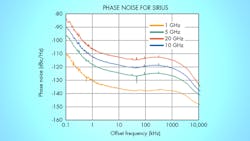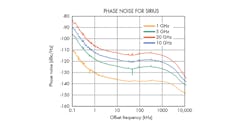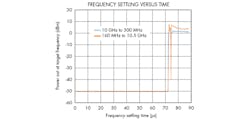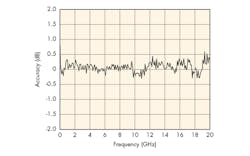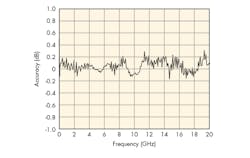Check the Specs When Selecting a Signal Generator
This file type includes high-resolution graphics and schematics when applicable.
Testing of RF/microwave semiconductors, components, and systems incorporated in everything from commercial wireless systems to military radar applications often involves the ubiquitous signal generator. These instruments may be employed for continuous-wave (CW) or pulsed signal generation, local-oscillator (LO) substitution when evaluating receivers and transmitters, and stimulus and response measurements.
When selecting a signal generator for an RF/microwave test system,1 it is important to understand the key specifications like output power, phase noise, level accuracy, spurious levels, harmonics. However, one shouldn’t take a casual approach to such details as frequency switching speed and calibration time, which may be critical to a particular application.
The limits of a signal generator will be the limits of a measurement system’s capabilities, especially when characterizing high-performance devices under test (DUTs). For example, when testing an amplifier with a signal generator exhibiting high levels of harmonic distortion or spurious signal content, it becomes difficult to determine whether a test system’s analyzer is measuring the amplifier’s or signal generator’s performance. By better understanding signal-generator specifications, one is able to more clearly discern the tradeoffs between price and performance, and the right source can be found for a particular application.
Phase Noise and Other Vital Specs
Test-and-measurement requirements vary according to the end system, but for many applications, including communications and radar systems, signal-generator phase noise (Fig. 1) is critical in determining the dynamic range and signal sensitivity of a test system. High phase noise reduces the efficiency of radar systems in resolving closely spaced targets or tracking both slow- and fast-moving targets simultaneously. Similarly, in wireless communication systems, high phase noise reduces a receiver's selectivity to switch between narrow radio channels, leading to high bit error rates (BERs).
CW signal generation in verification tests such as intermodulation-distortion (IMD) measurements, noise figure measurements, phase-noise tests, and third-order-intercept (TOI) measurements requires a signal generator with high spectral purity. High spectral purity refers not only to low phase noise, but also low harmonic levels and low spurious content.
The harmonic performance of a signal generator must be analyzed separately from other spectral-purity parameters (e.g., spurious noise or phase noise), depending on the application under test or the frequencies required for a test. In general, a signal generator will not exhibit low harmonics across its entire frequency range. However, some signal generators are designed with internal filters, such as highpass filters, to reduce harmonic signal levels across different frequency bands. This is generally true at low frequencies for a broadband signal generator.
Switching speed is an important signal-generator parameter for many applications, like when testing frequency-hopping radios. Fast switching synthesizers also can be valuable for production testing, since higher-frequency switching speeds mean faster test times and higher product throughput. When a signal generator or frequency synthesizer spends less time transitioning from one frequency to another during a sweep or a sequence of test frequencies, more time is available to execute measurements.
Signal generators have historically incorporated yttrium-iron-garnet (YIG) oscillators as signal sources when low phase noise was required, and voltage-controlled oscillators as signal sources when there was a need for fast frequency tuning. Because of the two traditional architectures, the notion has arisen that fast switching speed and low phase noise are mutually exclusive signal-generator parameters. However, some applications, such as testing RF integrated circuits (RFICs), may demand both low phase noise and fast switching speed.
One example of a commercial instrument that handles both parameters efficiently is National Instruments' model PXIe-5654 modular RF signal generator from National Instruments, which operates from 250 kHz to 20 GHz. It employs a low-phase-noise oven-controlled crystal oscillator (OCXO) that is optimally translated to the range of output frequencies while maintaining the low-phase-noise profile of the OCXO.
The typical phase-noise characteristics of the signal generator are shown in Fig. 1.2 For example, at 20 GHz, the single-sideband (SSB) phase noise is –113 dBc/Hz offset 10 kHz from the carrier. It improves to –119 dBc/Hz offset 10 kHz from a 10-GHz carrier, notably better than the phase-noise performance of many microwave YIG-based frequency synthesizers. Further from the carrier, the phase noise of the NI PXIe-5654 remains flat for several megahertz and then drops down to the noise floor.
Since the signal generator is based on a VCO architecture, it also provided fast frequency switching speeds.3 At lower frequencies, phase noise improves by 6 dB/octave due to frequency division.
Settling Time
Manufacturers are under pressure to increase production-line throughput while decreasing the cost of test. At the same time, test engineers constantly pursue more measurement data without significantly lengthening the time required for measurements. When using a signal generator, it is critical that a test engineer be familiar with all of the factors that impact frequency switching time and amplitude settling time.
Figure 2 shows the frequency-settling-time characteristics of the NI PXIe-5654.4 Two separate frequency transitions are given: the vertical axis shows output power at the target frequency, while the horizontal axis reveals the time following the trigger used to initiate a change in frequency. The blue curve indicates a frequency transition from 10.0 to 0.5 GHz, and the orange curve shows a transition from 160 MHz to 10.5 GHz.
In both cases, the frequency settles to within 5 ppm of the target frequency well within 100 µs. The instrument’s VCO-based architecture makes it possible to achieve fast frequency-switching speeds throughout the frequency tuning range without depending on the size of the jump in frequency.
Amplitude settling errors will play a part in a signal generator’s settling time, with fewer errors usually requiring longer switching times. If some amplitude errors can be tolerated in a measurement, faster settling times are possible. For example, with an NI PXIe-5654 signal generator, if greater than 2-dB amplitude settling error can be tolerated, a 100-point sweep can be completed in about 30 ms.
By performing such a measurement in list mode, amplitude errors can be measured and corrected for all points with the aid of a power meter (Fig. 3). This technique can ultimately shave off hundreds of milliseconds to seconds from every frequency sweep.
Understanding how software, such as list-mode functions, can be applied to a particular signal generator helps decrease test time while still minimizing amplitude settling errors. Switch points (frequency and power-based) and mechanical attenuators can add significant time to frequency sweeps with hundreds of points. But changing the state of an instrument’s mechanical attenuator can decrease settling time by 20 ms. For example, the datasheet for the NI PXIe-5654 provides guidance on how factors such as mechanical attenuators can impact sweep times.
Flexible Architecture
High-volume production testing often requires multiple racks of test signal generators, typically under software and computer control. The choice of signal generator or frequency synthesizer can impact performance as well as the amount of floor space, power consumption, heat dissipation, software complexity, and overall cost of test. A signal generator optimized for use in automatic-test-equipment (ATE) installations should be compact in size without compromising electrical performance.
Modular instruments such as the PXI-based NI PXIe-5654 occupy a fraction of the volume of traditional 19-in.-wide rack-mount instruments while allowing for additional complementary, and similarly compact, modules like the NI PXIe-5696 amplitude extender module. This module’s amplitude level control (ALC) performs corrections in the amplitude control circuitry of the PXIe-5654 signal generator, resulting in a leveling of power from –110 to +30 dBm across a frequency range of 250 kHz to 20 GHz.
To illustrate the flexibility possible with a modular-test-equipment architecture, two PXIe-5654 signal generators were used with a single PXIe-5696 amplitude extender module for two-tone power-amplifier (PA) and front-end-module (FEM) testing (Fig. 4). Normally, a single module would be insufficient to make amplitude corrections for two separate signal generators. But in this case, the flexibility allows for simplified two-tone testing, with signals from a PA or FEM fed to a signal analyzer for evaluation.
A signal generator’s output power is another important specification because of the loss of signal power through cables and switches leading to a DUT in a test setup. When specifying a test signal source, sufficient margin should be allocated for output power to compensate for such losses in the test setup. It is much easier to drop signal levels with an external attenuator (which is passive) than to boost signal levels with an external amplifier (which requires bias energy).
Some tests (e.g., PA characterization) require high signal output levels from a signal generator while maintaining high level accuracy and good spectral purity. Power accuracy is critical because a DUT’s response is likely to vary with the signal-generator power level. For such requirements, multiple RF attenuators may be used to extend the dynamic range of a signal generator’s output power, along with an ALC circuit to increase the accuracy of the output signal.
To demonstrate how power accuracy can change at different signal generator output power levels, the typical power accuracy of the NI PXIe-5654 signal generator with an NI PXIe-5696 module is plotted in Figs. 5, 6, and 7 for output levels of –100, –70, and –40 dBm, respectively.
Another important consideration for a signal generator is amplitude stability with time and temperature. Compared to an open-loop signal source, a signal generator with ALC circuitry will offer much higher amplitude stability with temperature. In an open-loop architecture, the temperature drift of all components in the signal chain contribute to the signal generator’s overall temperature-drift performance.
To improve the overall amplitude stability, some signal generators may incorporate temperature-compensation circuitry. When comparing signal generators, it is best to check the specification for amplitude drift over temperature, usually provided in dB/°C. Some generators also implement temperature compensation to improve the overall amplitude stability. This number is far more critical in a majority of applications than the amplitude accuracy specification provided by most test-equipment vendors—the latter is generally a measure of the amplitude accuracy at the signal generator’s output port; not at a DUT’s input port.
By carefully weighing these and other specifications, it is possible to maximize the benefits of an investment in a signal generator. By balancing the needs of different test applications with performance parameters such as phase noise, settling time, and output power, one can choose a signal generator that should provide satisfying results for many years.
Shivansh Chaudhary is Product Engineer, Suresh Ojha is Principal Engineer, and Gautam Talreja is R & D Section Manager at National Instruments.
Looking for parts? Go to SourceESB.
References:
1. Signal Generator Fundamentals, National Instruments.
2. NI PXIe-5654 datasheet, National Instruments.
3. Alexander Chenakin, “Building a Microwave Frequency Synthesizer, Part 5: Advanced Techniques,” Artech House, Norwood, Mass., 2010.
4. National Instruments, Application Note, “Choosing the right signal generator."
This file type includes high-resolution graphics and schematics when applicable.
